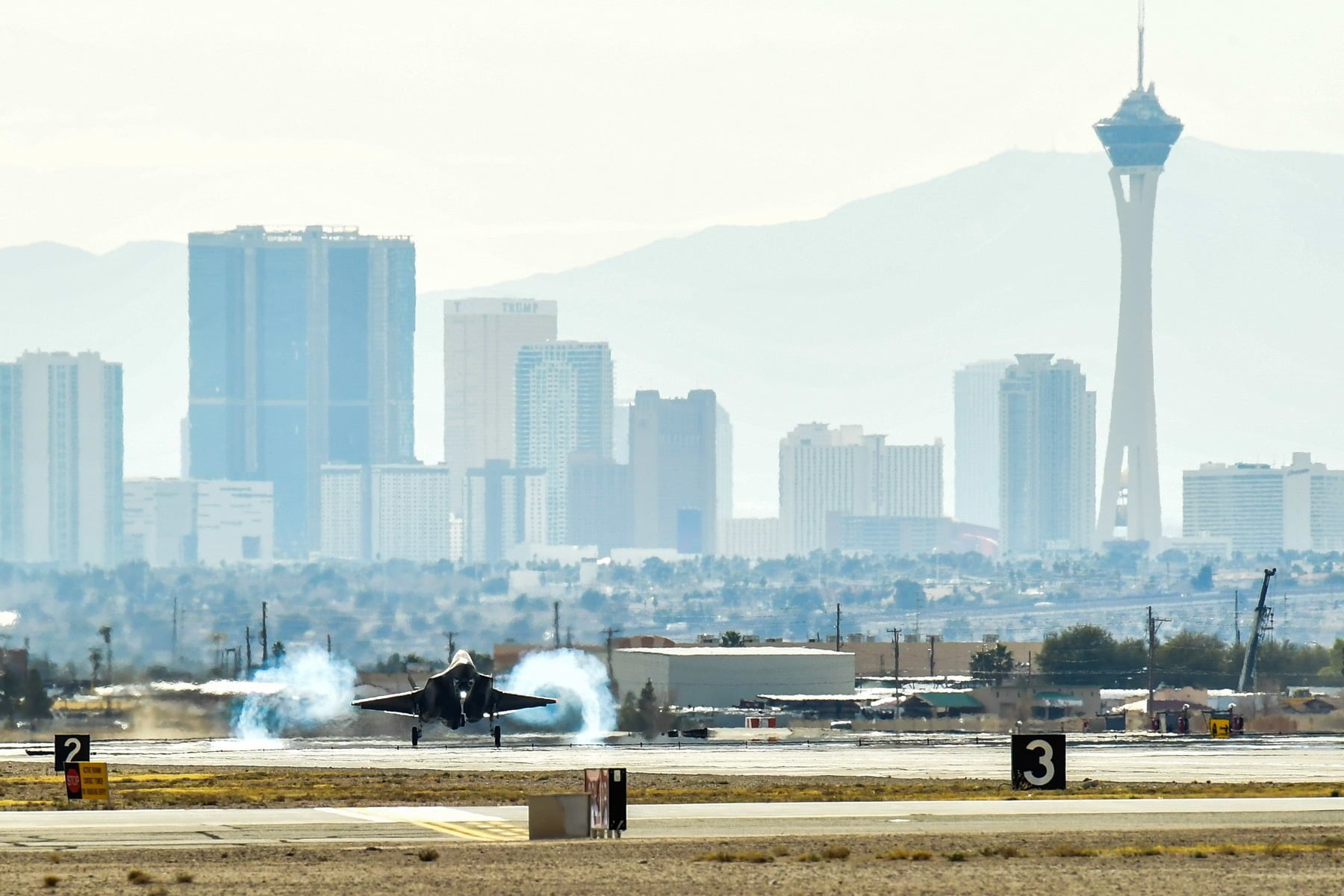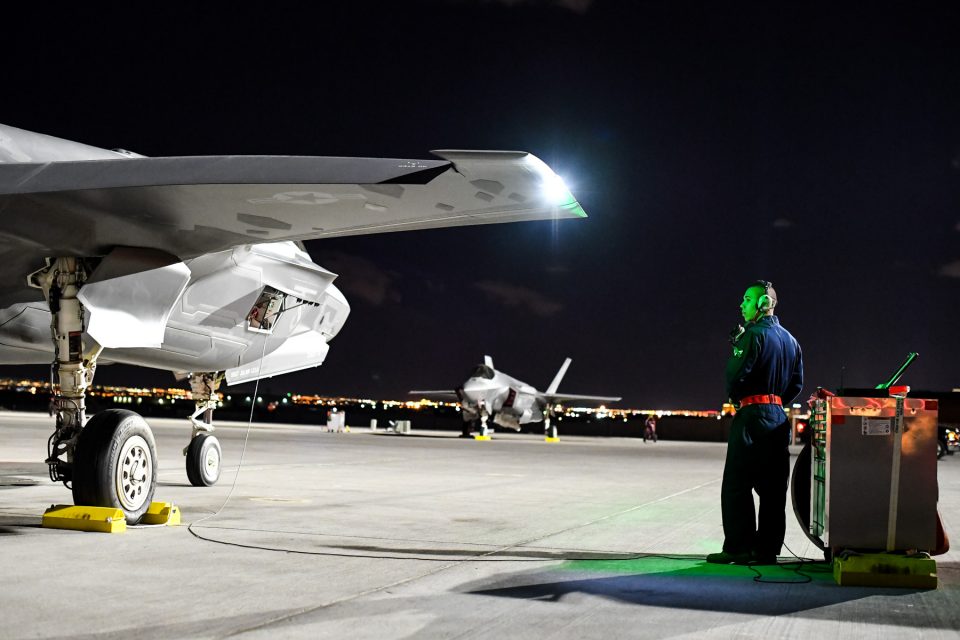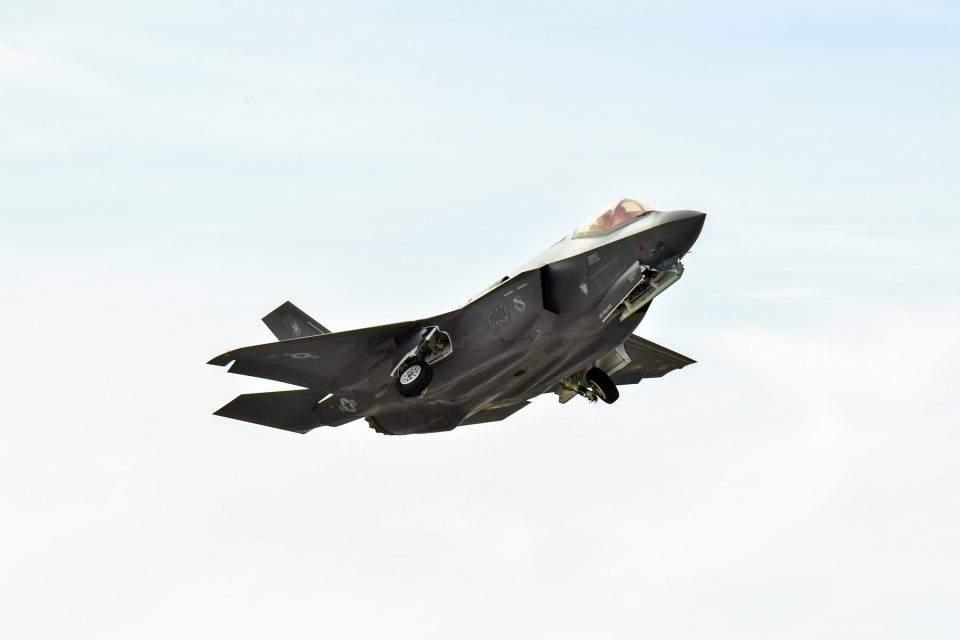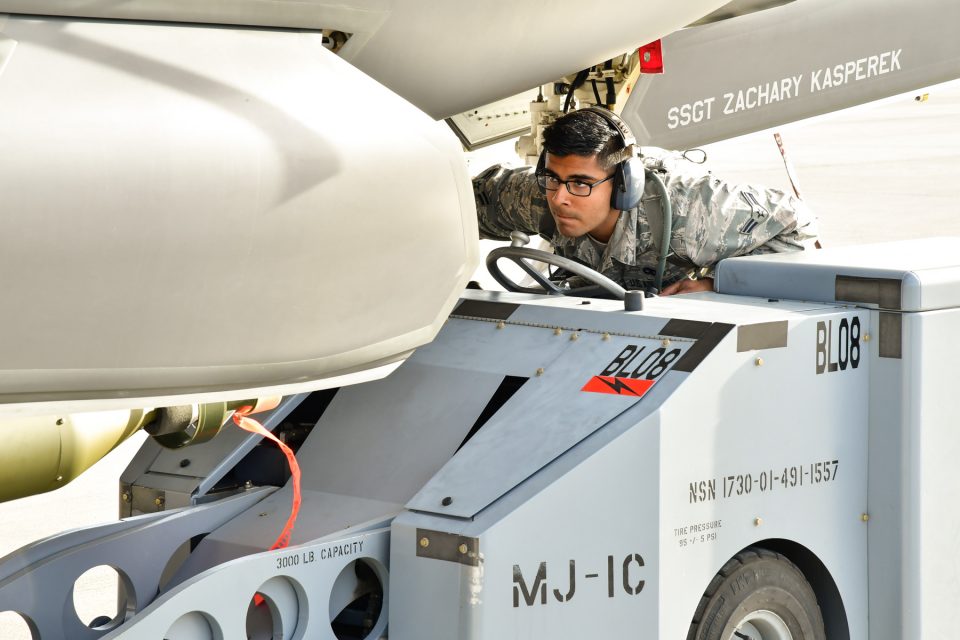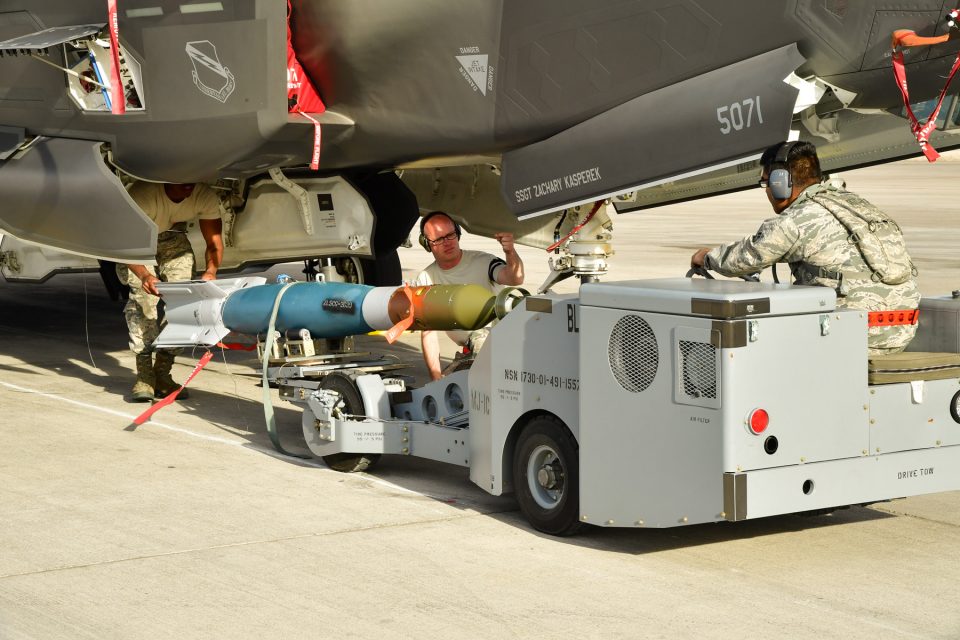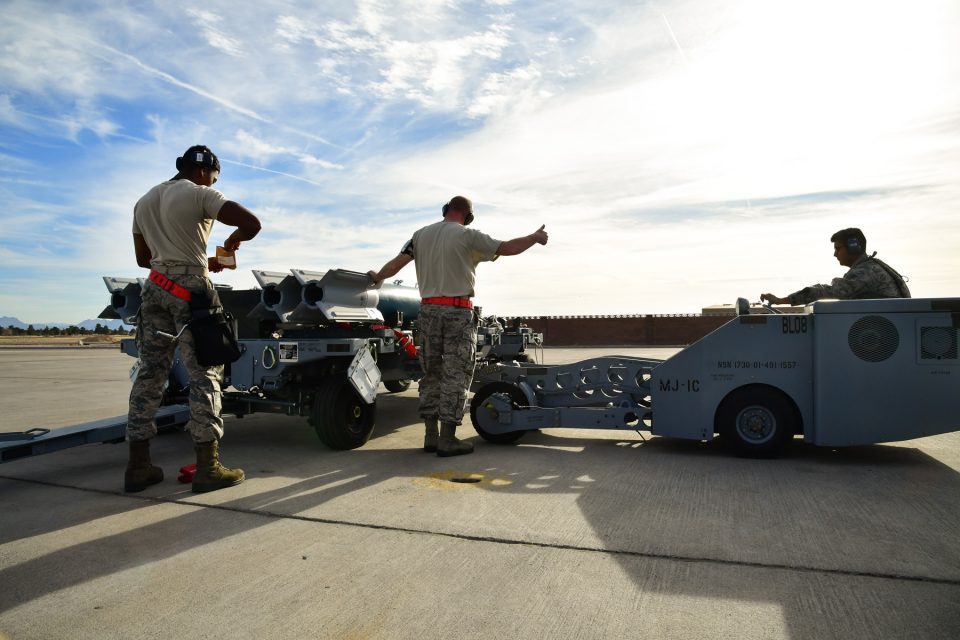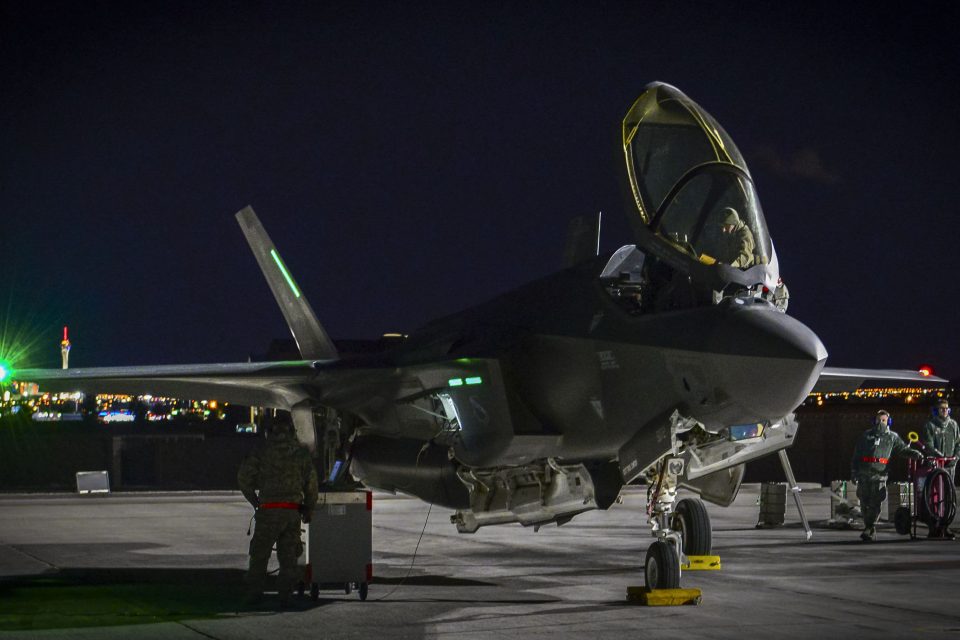2017-02-11 We have focused on the impact of fifth generation aircraft for many years.
Our focus has been upon their impact on the renorming or rebasing of airpower or the transformation of combat approaches and the shaping of new concepts of operations.
https://sldinfo.com/flipbooks/Renorming%20Air%20Power/RenormingAirPower/
http://online.flipbuilder.com/lrty/wdem/
https://sldinfo.com/the-f-35-and-21st-century-defence-shaping-a-way-ahead/
For the Marines, we focused early on with regard to the impact of Osprey and then F35 as shaping what we called three-dimensional warriors.
We have also interviewed a number of players in 4th-5th generation integration and have discussed how the way ahead is shifted for both 4th and 5th generation aircraft in the reshaping of co-ops.
For us, it is has never been about the F-35 alone, but the impact of the F-35 global enterprise as a change agent in the reshaping of airpower.
https://sldinfo.com/three-dimensional-warriors-the-re-making-of-air-assault/
https://sldinfo.com/download-the-three-dimensional-warriors/
No better validation of the approach has been given than by the recent discussions at the Norwegian Airpower Conference held in Trondheim this week.

Although the very title of the conference focused on the F-35, the conference really discussed the way ahead with the transformation of the Norwegian combat force to provide for better national defense.
The F-35 is clearly crucial to this effort, as much as a trigger for change as the bedrock for change.
Red Flags are clearly exercises where the integration of the F-35 in the transformation of airpower is a core effort.
The first Red Flag where an F-35 flew was last year as VMFA-121, the operational squadron now operating in Japan, participated.
According to a story published in July 2016 by the USMC, the arrival of the F-35B and its role in Red Flag was discussed.
Six F-35B Lightning IIs with Marine Fighter Attack Squadron (VMFA) 121 participated in Red Flag 16-3, making it the first time in history that the fifth generation fighter has taken part in the three-week long exercise at Nellis Air Force Base, Nevada.
Red Flag is a multiservice air-to-air combat training exercise including the Army, Navy, Air Force and the Marine Corps.
According to Lt. Col. J.T. Bardo, commanding officer of VMFA-121, this is the first exercise of this magnitude that the F-35 has participated in and serves as a valuable training opportunity for the squadron.
During the training, VMFA-121 conducted defensive and offensive counter air exercises, strategic attacks, targeting, and combat search and rescue training.
“We’re really working on showcasing our surface-to-air capabilities,” said Maj. Brendan Walsh, an F-35 pilot with VMFA-121. “The F-35 is integrating by doing various roles in air-to-air and air-to-ground training.”
The F-35 is equipped with an integrated sensor package more powerful than any fighter aircraft, also combining radar-evading stealth with speed and fighter agility.
“With the stealth capability, the biggest thing that this aircraft brings that the others do not is situational awareness,” said Walsh. “The sensor sweep capability that the F-35 brings to the fight, not only builds those pictures for me, but for the other platforms as well. We’re able to share our knowledge of the battle space with the rest of the participants in order to make everyone more effective.”
Red Flag 16-3 has roughly 3,500 service members involved for the entire exercise. The training scenarios require all the branches to come together, which is extremely common in real-life battle scenarios.
“These opportunities to operate in a joint environment with our partner services are rare,” said Bardo. “We’re excited to be here, to bring the F-35 to the exercise and capitalize on all its strengths and integrate with the other players out there.”
In the final photo, Lt. Col. J.T. Bardo, second from left, commanding officer of Marine Fighter Attack Squadron (VMFA) 121, answers questions about the F-35B Lightning II participating in exercise Red Flag 16-3 at Nellis Air Force Base, Nev., July 20.
According to one of the pilots involved in that exercise, this was his F-35 experience.
Mo: I was leading a four ship of F-35s on a strike against 4th Gen adversaries, F-16s and F/A-18s.
We fought our way in, we mapped the target, found the target, dropped JDAMs on the target and turned around and fought our way out.
All the targets got hit, nobody got detected, and all the adversaries died. I thought, yes, this works, very, very, very well.
Never detected, nobody had any idea we were out there.
https://sldinfo.com/the-moment-pilots-first-realized-the-f-35-was-something-extraordinary/
And Lt. Col. Bardo discussed the F-35B in Red Flag as follows:
Lt. Col. Bardo noted that there were many F-16 National Guard pilots who were there, some of which had flown with the F-22 but had not flown with the F-35.
They soon learned that you did not want to be an adversary but to leverage what the F-35 brought the fight.
Now the F-35A has come to the first Red Flag in 2017.
Recent stories published by the USAF have highlighted several aspects of the F-35 engagement in Red Flag.
Among other items highlighted have been the very high kill to survival ration of the aircraft, the maintainability of the aircraft during the exercise, and the significant sortie generation rate, and the off-boarding of weapons strikes as the F-35 identified targets and aircraft with very good weapons loading like Typhoon were able to strike targets identified by F-35.
On Data Sharing and Off-Boarding
NELLIS AIR FORCE BASE, Nev. — The F-35A Lightning II can carry thousands of pounds of bombs, but its ability to gather and share information is just as deadly.
Pilots from the 388th and 419th Fighter Wings brought this fifth-generation technology to Red Flag 17-1 air combat exercise here.
The F-35 is designed to share what it sees with legacy aircraft, as well as other F-35s. A combination of stealth, electronic attack, information sharing, and other features make the platform an invaluable part of a modern air-strike package.
“Our strength with the F-35 has been finding the threats,” said Lt. Col. George Watkins, 34th Fighter Squadron commander. “We use our onboard system to geo-locate and get a picture of the target, day or night, through the weather. We pass that threat information to others while using our stealth capability. We can get a lot closer to the advanced threat than anyone else can get. That allows us to target them out and take out critical assets.”
During one scenario, the Airmen were given a general location by advanced intelligence, surveillance and reconnaissance aircraft. The F-35s were tasked with finding a convoy carrying a “high-value target.” The F-35s advanced targeting capabilities were able to pinpoint the convoy’s location. They then communicated that to British Typhoon fighters who took out the target, said Lt. Col. Dave DeAngelis, F-35 pilot and commander of the 419th Operations Group, Detachment 1.
The F-35 uses the Link 16 secure architecture to communicate with fourth-generation aircraft in the Red Flag fight and combined with the Multifunction Advanced Data Link (MADL), which allows pilots to see the battlespace and share that data with other F-35 pilots.
“The thing that’s great about having Link 16 and MADL onboard and the sensor fusion is the amount of situational awareness the pilot has,” Watkins said. “I’m able to directly communicate with specific formations and I can see the whole war, and where all the other players are, from a God’s-eye view. That makes me a lot more effective because I know who to talk with and at what times, over the secure voice.”
While Link 16 connects fourth- and fifth-generation fighters, the F-35’s MADL system is key for their tactics and mission success.
“MADL is an integral part of our day-to-day ops with the F-35,” Watkins said. “It’s the data link that we use to communicate just between F-35s. It’s a solid architecture and from my experience, it’s been very stable. The pilots rely on it for fighting, and at night we fly what we call sensor formations and we use MADL to keep our situational awareness from each other.”
F-35 pilots report that the onboard fifth-generation technology is amazing and has been proven effective through the Red Flag exercise.
“The information that we get from our sensors provides a phenomenal picture of the battlespace,” said Maj. James Schmidt of the 34th Fighter Squadron. “When a 4-Ship of F-35As are sharing information, it increases the lethality of the entire force.”
“I could be pointed away from the target area and still have an accurate picture of what’s behind me,” he added. “It adds a sense of confidence that when I pitch back into the fight, I don’t need the extra time to build the picture again before bringing the fight to the enemy. We also provide what our aircraft sees to fourth-generation assets, allowing them to see things beyond what they would normally be able to.”
Flying began at Red Flag Jan. 23 and to date, Hill’s Airmen have generated 155 sorties, including their first 10-jet F-35A sortie Jan. 30. They “turned around” and launched eight jets that afternoon. The Airmen will generate 16 to 18 sorties every day through Feb. 10.
Hill AFB will eventually be home to three operational F-35A fighter squadrons with a total of 78 aircraft by the end of 2019. The first operational F-35As arrived at Hill in October 2015 and reached initial operational capability in August 2016. The active duty 388th FW and Air Force Reserve 419th FW will fly and maintain the jet in a Total Force partnership, which capitalizes on the strength of both components.
On Maintainability
NELLIS AIR FORCE BASE, Nev. (AFNS) — The debut of the F-35A Lightning II at Red Flag has afforded the pilots and maintainers of the aircraft a chance to be a part of the Air Force’s premier air-to-air combat training exercise.
For Airmen involved with the F-35, Red Flag 17-1 provides a unique type of training that prepares them to be fully mission ready.
“It’s been great coming here and doing something that some of us haven’t necessarily done before,” said Senior Airman John Girtman, an F-35A avionics systems specialist assigned to the 388th Aircraft Maintenance Squadron at Hill Air Force Base, Utah. “It gives us the ability to exercise our strength. Being able to work in an environment like Red Flag and seeing all of our training and hard work from back home come to fruition is extremely beneficial.”
A major part of the success so far of the F-35 aircrew can be contributed to the planning and training that went into getting prepared for Red Flag 17-1.
“Before we came out to the exercise we sat down and came up with a game plan as to what we may encounter or any issues we might face and how we can overcome those challenges,” said Staff Sgt. Brandon Bailey, a 388th AMXS crew chief.
“Now that we are here, the challenges we face during Red Flag helps us see what kind of challenges we might be faced with in a deployed environment and how we can overcome those,” Bailey said. “The things we learn during this exercise will allow us to progress and get better.”
Red Flag exercises are fast-paced and provide aircrews the experience of multiple, intensive air combat sorties in the safety of a training environment.
“Here at Red Flag there is a great sense of urgency,” said Airman 1st Class Anhre Bourgeois, a 388th AMXS F-35A weapons troop. “We are always on the go. If it ever came to a real world contingency I think it will be the same thing. Just constantly on the go to get the job done and the jets up in the air. Red Flag really prepares me for that.”
The F-35’s combined lethality and survivability make it the platform of choice for operations in a highly-contested threat environment. The F-35 will be the backbone of future joint and combined air operations, enabling critical interoperability.
“It’s an eye opening experience to be out here,” Bourgeois said. “It’s not every day that you get to work on an aircraft as smart as the F-35A. It’s definitely taught me a lot and I’m very humbled to be working on an aircraft like this.”
This is the first deployment to Red Flag for the F-35A and the first large movement since the Air Force declared the jet combat ready in August 2016.
Lt. Col. George Watkins, the 34th Fighter Squadron commander, said, “It is exciting to integrate the newest operational fighter squadron and the newly initial operational capability F-35A with all the other experienced warfighter including two of our partner nations. The professional aggressors are giving us great training, but enemy is no match for our integrated fourth- and fifth-generation Air Force.”
http://www.hill.af.mil/News/Article-Display/Article/1065681/f-35a-maintenance-sparks-red-flag-17-1
NELLIS AIR FORCE BASE, Nev. — When it comes to the F-35A, much is made of the edge its fifth-generation technology gives pilots, but America’s newest fighter aircraft is also proving capable in the hands of maintainers.
Airmen from the 388th and 419th Fighter Wings’ 34th Aircraft Maintenance Unit deployed alongside the F-35A Lightning II to the Red Flag air combat exercise at Nellis AFB, Nevada, Jan. 20. Flying began Jan. 23.
Since the exercise kicked off, Hill’s Airmen have generated 155 sorties, including their first 10-jet F-35A sortie Jan. 30. They “turned around” and launched eight jets that afternoon. The Airmen will generate 16 to 18 sorties every day through Feb. 10, said 1st Lt. Devin Ferguson, assistant officer in charge of the 34th Aircraft Maintenance Unit.
Thus far, there have only been two non-effective sorties (when an aircraft takes off, but an issue prevents completion of the mission) — one generator failure and one landing gear problem. Even with those, the F-35A “mission-capable” rate is well above 90 percent, Ferguson said. Legacy aircraft average 70 to 85 percent mission-capable. The aircraft and Airmen are performing so well that the wings have added more F-35A sorties to the schedule.
“Normally when you come to an exercise like Red Flag you have to temper expectations when scheduling sorties because the ops-tempo is so high and there’s so much activity. It’s pretty much guaranteed that you’ll run into maintenance issues,” Ferguson said. “That hasn’t been the case so far, and the issues we have had, we’ve been able to address quickly.”
Part of the success is due to the maintainer-friendly design of the jet, an improvement over fourth generation aircraft.
“The repair process is smoother with most issues we encounter than with other aircraft I’ve worked on. The jet’s systems specifically identify a break and we’re able to correct the issue and return the aircraft to service very quickly,” said Senior Master Sgt. Robert Soto, lead production superintendent for the 34th Aircraft Maintenance Unit, a career maintainer who has worked during several Red Flags.
On Thursday, one F-35A’s generator failed. If this were an older jet – like the F-16 – maintainers would have to break out a fault-isolation manual and go through a lengthy troubleshooting process. With the F-35A, the Autonomic Logistics Information System identified the exact part that caused the generator failure, and the Airmen could quickly perform the repair and return the aircraft to service.
“This jet is proving to be one of the most reliable combat aircraft I’ve ever seen,” said Master Sgt. Kyle Kutcher, a maintenance section chief with the 419th Aircraft Maintenance Squadron. Kutcher has maintained four different fighter aircraft and has attended seven Red Flags. “This jet makes it really easy for my maintainers because it’s designed to streamline maintenance procedures.”
Red Flag is providing maintainers an opportunity to “write the book” on F-35A combat maintenance. For the first time, Airmen are regenerating aircraft in a combat scenario. Jets land after a mission, are refueled, loaded with munitions, inspected for service, and prepped for flight – then head back to the fight.
“Since we’ve gone IOC, we’re combat capable. But day in and day out we’re working to increase our combat capability, and Red Flag is a great place to do that,” said Col. Michael Miles, 388th Maintenance Group commander. “We’re unlocking our aircraft’s full potential, flying more of them than ever, and doing it at combat pace.”
The maintainers are in a contested environment, too. During Red Flag, planners throw scenarios at the Airmen, denying them key capabilities. “You’ve lost aircraft systems, you’ve lost internet connectivity, or communications – now fix it.”
With a legacy platform, the responses to many of these potential problems are set in stone, or generate hours of troubleshooting, and have been for years, but for F-35A maintainers, they are learning and growing with each opportunity.
“At home, our young maintenance Airmen are practicing and learning every day. Here, we’re able to put that training into a realistic scenario and watch them succeed and learn how to overcome challenges,” Soto said. “This exercise is teaching us a lot and it’s great to see them come up with innovative solutions to problems we’ve never tested them with before.” Soto said.
On Transformation
NELLIS AIR FORCE BASE, Nev. — After eight days “at war” the F-35A Lightning II is proving to be an invaluable asset during Red Flag 17-01, the Air Force’s premier air combat exercise held at Nellis Air Force Base, Nevada.
The F-35A is a fifth-generation, multi-role stealth fighter designed to gather, fuse, and distribute more information than any other fighter in history.
Lt. Col. George Watkins, an F-35 pilot and 34th Fighter Squadron commander, said flying the F-35A in combat “feels like air dominance.”
“I’ve had four of my (F-35A) pilots come back from missions, guys who have flown the F-15 and F-16 at Red Flag for years, and tell me ‘This is amazing. I’ve never had this much situational awareness while I’m in the air. I know who’s who, I know who’s being threatened, and I know where I need to go next.’ You just don’t have all of that information at once in fourth-generation platform,” Watkins said.
Pilots and maintainers from the 388th and 419th Fighter Wings at Hill AFB, Utah, deployed the F-35A Lightning II here Jan. 20 and began flying in the exercise Jan. 23.
Since the exercise began, Hill’s Airmen have generated 110 sorties, including their first 10-jet F-35A sortie Jan. 30 and turned around and launched eight jets that afternoon. They have not lost a single sortie to a maintenance issue and have a 92 percent mission-capable rate, said 1st Lt. Devin Ferguson, assistant officer in charge of the 34th Aircraft Maintenance Unit. Legacy aircraft average 70 to 85 percent mission-capable.
Red Flag is designed to provide Airmen with realistic combat scenarios and increase survivability in real combat. The three-week exercise pits “Blue Air” (friendly) against “Red Air” (enemy) in an all-out air war featuring air-to-air, air-to-ground, search and rescue, and special forces elements. Planners say this is rigorous training for even proven weapons systems and a good test for the F-35A, still in the initial stages of operational capability.
Flying alongside F-22 Raptors, as well as a variety of U.S. and coalition fourth-generation aircraft from Australia and the United Kingdom air forces, the capabilities of the F-35A are being put to the test with robust combat scenarios that focus on the jet’s core capabilities – air interdiction, suppression of enemy air defense.
“The first day we were here, we flew defensive counter-air and we didn’t lose a single friendly aircraft,” Watkins said. “That’s unheard of.”
Because of the aircraft’s increased capability, exercise planners have increased the complexity of the scenarios for the “Blue Air” players.
“The number of adversaries has increased, their skill level has increased, the sophistication of the surface-to-air threat has increased,” Watkins said.
Facing highly sophisticated surface-to-air threats is a challenge for fourth-generation aircraft. With the F-35A, pilots can gather and fuse data from a multitude of sources and use the jet’s advanced sensors to precisely pinpoint a threat. Then they can take it out with one 2,000 pound bomb. It would be impossible for a fourth-generation aircraft to survive such a mission, according to Lt. Col. Dave DeAngelis, F-35 pilot and commander of the 419th Operations Group, Detachment 1.
While the F-35As eliminate the advanced ground threats, F-22s are dominating air threats and the pair are clearing the way for fourth-generation assets to operate.
“It is a step up and a look into the future for us,” said Royal Australian Air Force Group Captain Stuart Bellingham, Air Operations Center director at Red Flag. “It’s really exciting to work alongside the F-35A and the F-22 to understand how we best integrate that into a high end fight in the training scenarios that Red Flag provides.”
The first operational F-35As arrived at Hill AFB in October 2015. The base will eventually be home to three operational F-35 fighter squadrons with a total of 78 aircraft by the end of 2019. The active duty 388th FW and Air Force Reserve 419th FW will fly and maintain the Air Force’s newest fighter aircraft in a Total Force partnership, which capitalizes on the strength of both components.
The first slideshow highlights the F-35Bs at Red Flag in 2016 and are credited to the USMC.
The second slideshow highlights the F-35As and their maintainers at Red Flag 2017-1 and are credited to the USAF.
The third slideshow highlights the RAAF at Red Flag 2017-1 and are credited to the RAAF.


